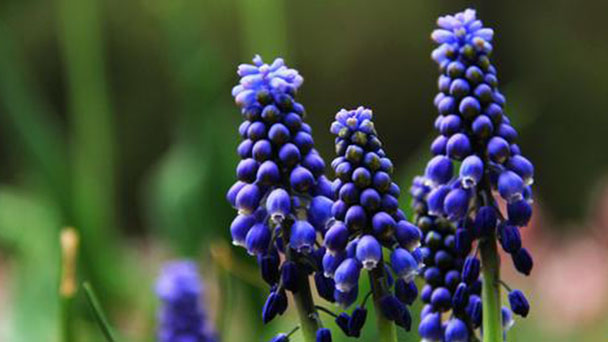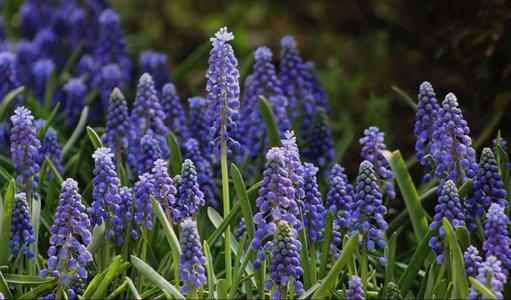Grape hyacinth (Muscari botryoides) profile
Written by admin
Mar 05 2021

Grape hyacinth, scientific name Muscari botryoides, is a small bulbous flower ground cover plant introduced from Europe with excellent perennial herbs. Grape hyacinth is a perennial flower with strong ornamental value. It has low and neat plants, dignified inflorescence, beautiful flower appearance and gorgeous colors. It is quiet and elegant against the bright and tender green leaves, and it is a famous perennial flower that blooms in early spring. Grape hyacinth is an excellent flower-watching plant, with good ornamental effect. The layout at home also looks very small and fresh, making the home full of dynamic spirit. If you also like Grape hyacinth, you can try to plant it.
Grape hyacinth picture

Grape hyacinth morphological feature
Grape hyacinth is a small bulbous flower of Liliaceae.Lenticed bulb ovoid, white. Leaves are basal, semiterete linear, fleshy, dark green, margin often encoiled, 15 -- 30cm long, 0.6 cm wide. The plant height is 15~30cm, the underground bulb is covered with a white membrane, the bulb diameter is 1~3cm, and the height is about 1.5cm. Flower Yan upright, 15- 20 cm high, top clusters of 14-25 small globular flowers, stems out from the leaves, cylindrical, about 15cm long, above the dense birth of many bells of the floret, pedicel drooping, flowers cyan, light blue, blue-purple, white powder and so on. Most florets are dense and pendulous, corolla tapered at the tip, blue flowers or white tips, and there are white, flesh-colored, pale blue and double varieties. Common varieties are white - flower varieties, light - blue - flower varieties and flesh-colored varieties.
Ecological habit of the Grape hyacinth
Grape hyacinth originated in central Europe, the Netherlands cultivated more. Grape hyacinth likes warm, cool climate, moist and sunny environments. Grape hyacinth is pleasant to light and also bear shade, cold resistance is also stronger. The suitable growth temperature is 15℃ to 30℃, suitable for the growth of humus rich, loose, fertile, well drained sandy loam soil. Dormant in summer, evergreen leaves in winter, cold resistance is strong, in Beijing area only the end of the yellow withered.
Grape hyacinth has strong cold resistance, and can be cultivated in open field for overwintering in East and North China. Early summer should be cool, also resistant to half shade. Grape hyacinth is pleasant to fertile, loose and good drainage leaf soil. Bulbs have dormant habit in summer, germination unearthed in autumn, flowering in spring. In spring, the ground part withered into the dormant period.
Unlike tulips and daffodils, which are dormant at harvest time, Grape hyacinth starts to differentiate between leaf buds and flower buds only after the dormancy is lifted. By contrast, Grape hyacinth's flower buds start to differentiate early, when leaf and flower buds begin to differentiate before the plants on the ground have withered before the seeds are harvested.
How to grow and care for grape hyacinth
1. Soil
Grape hyacinth is highly adaptable, easy to cultivate and manage, and can be transplanted at any time. It likes fertile, loose and well-drained leaf rot soil.
2. Watering
Grape hyacinth after planting to keep the soil moisture, dry early should be promptly watered, flowers should stop watering after the drop.
3, Light
Grape hyacinth likes sufficient light environment, also tolerant to half shade, when the spring flower buds grow, move to 60%-70% sunshine, make the flower stem elongate quickly.
4. Temperature
Grape hyacinth has a strong cold resistance, and the suitable temperature for germination is 20-25 9C. It can be cultivated openly in East and North China for overwintering.
5. Fertilizer
Top fertilizer should be paid attention to after Grape hyacinth sprouts in early spring. After leaves grow, nitrogen, phosphorus, and potassium diluent can be applied to promote development.
6. Insect diseases:
Common smut (mainly harmful to flowers), root nematode disease, stem nematode harm. Smut with 50% tobujin wettable powder 1000 times liquid spray; Nematodes can be killed by water hole irrigation with 80% Dichlorohydrin emulsion 15 to 20 times.
7. Dormancy
Bulbs have dormancy habits in summer, and the aboveground wilts into the dormant period in May. It is best for bulbs to enter the dormant period when they are relatively dry.
How to grow grape hyacinths in pots
Buy sufficient muscari bulbs to pressure some for indoor flowering in containers. The bulbs want about 10 weeks of chilling to put them together for blooming. Bulbs want temperatures of about forty stages F. to acquire the dormancy that will lead to growth, so the refrigerator is a best region to put together your grape hyacinth bulbs. Time the starting of the kick back length for about 22 to 24 weeks earlier than you desire the bulbs to bloom.
After chilling, plant 12 to 15 bulbs in a bulb pan or different container at least 6 inches round and 6 to eight inches deep. Moist potting soil is preferable. Place the bulbs about 1 inch aside with the uncovered suggestions pointing up.
Move the pot to a cool, darkish vicinity for about 10 weeks, till shoots about two inches lengthy have fashioned on all the bulbs.
Move the pot to a sunny location. Flower buds ought to show up inside two to three weeks.

Grape hyacinth propagation
Grape hyacinth is generally propagated by sowing or planting small bulbs. After the seeds are harvested, they can be broadcast directly on the ground in autumn, germinate in spring of the next year, and bloom 3 years later. Bulbs can be planted in the summer after the leaf withered, rooting in the autumn, before winter leaves.
Grape hyacinth species classification
Grape hyacinth belongs to the genus Cyanthes, with about 40 to 50 species, mainly distributed in the Mediterranean Sea and southwest Asia, and no wild species in China. There are no reports about the number of Grape hyacinth at home and abroad. At present, there are a total of four reported domestic introductions, Shanghai Jiao Tong University College of Agriculture and Biology, Northwest A & F University College of Horticulture, Xi 'an Botanical Garden and Guangdong Fashion Flower. Species are: American Grape hyacinth(Armeniacum), blue-purple; Armeniacum Blue Spike, Blue;Grape Hyacinth (Botryoides Album), white; Comosum, pink; Comosum Plumosum, pink purple; "Dark eyes," blue.
The purple grape
The purple grape (Cantat), a variety of purple flowers, has a tall plant with clusters of purple and blue grapes, but the flower tips are white, blue and white and very beautiful.
Sky blue
Heavenly Blue, purple variety, with dwarf plants and Blue grape-like flowers, like a bunch of ripe grapes, elegant and beautiful.
Phineas
Valerie Finis, a purple variety, has dense grape-like flowers that are pale blue with a slight silver reflection, producing a dreamlike color.
Deep blue
Neglectum, a violet variety, characterized by azure flowers which turn dark purplish blue when first opened, forming a bicoloured inflorescence with a white ring at the tip, resulting in a distinct color contrast.
White grape
White grape (Album), a variety of white flowers, characterized by small plants, small white flowers, dense clusters of grapes, very aromatic.
White lady
White Beauty, a White variety, is characterized by striped fleshy leaves and small, pure White grape-like flowers with dense clusters, contrasting with the dark green stems and green leaves.
Blue ear
Grape Hyacinth, a cultivar of Grape Hyacinth, has no obvious petals compared to the more distinct petals of other cultivars, which is quite different from Grape Hyacinth's Grape shape.The flower is a cluster of very small flowers that look like spiks like setaria, hence the name blue spike.Although the flowers do not look as nice as other grapes, they are still a special flower to look at.
Grape hyacinth distribution
Grape hyacinth is native to central Europe in France, Germany and southern Poland. It is later introduced into North China and cultivated in Hebei, Jiangsu, Sichuan and other provinces.
Grape hyacinth uses
Grape hyacinth is low, with delicate purple globules of flowers. Use it to decorate perennial sticks together with flower borders or embellish beside the rocks, green and smooth, simple and elegant. Potted plant puts windowsill, balcony or sitting room, do not have one time interest.
Flowering early, Grape hyacinth flowering time is longer, multi-purpose it decorate perennial mixed flower border or embellish beside the rocks, can also be potted or fresh cut flowers. Grape hyacinth is a good ground cover for landscaping, because it has low bushes, bright flowers, long flowering period and long green leaves.It is often used as ground cover under sparse forest or used for planting in patches, belts and edges of flower borders and lawns. Grape hyacinth is also used for embellishing bush plants in rock gardens. Potted family flowers also have good ornamental effect. Grape hyacinth can be used as underground, and also used for border or floral arrangement, which is of special interest.
Grape hyacinths toxicity
Grape hyacinths, often grown for their fragrant smell, are not toxic. However, it is easy to confuse them with common hyacinths, which are. Winter hardy in USDA zones 4 through 8, hyacinths form the backbone of many springtime gardens, but their poisonous bulbs require that you keep children and pets away from them. Eating even a small amount of the bulb can cause serious stomach upset. The poisonous compounds, calcium oxalate raphides, can also cause skin irritation.

Latest Updated
- Benefits of Bugleweed - 7 Science-backed Health Benefits
- Bugleweed Dangers & Side Effects - Is It Poisonous?
- How to Plant Evergreen Trees - What You Should Know
- When to Plant Evergreens - Grow Guide for Evergreen Trees
- 12 Wonderful Evergreen Shrubs for Your Garden
- 12 Popular Evergreen Plants with Pictures for Beginners
- When And How To Prune A Lilac Bush Like a Pro
- How to Grow & Care for Lilac Vine (Hardenbergia Violacea)
- Japanese Lilac Tree (Syringa Reticulata) Care & Propagation Guide
- Shumard Oak Pros and Cons - What to Know
Popular Articles
- Winter maintenance of Antirrhinum Majus
- How to Grow Terminalia Mantaly Tree
- How to Grow and Care for Crossostephium Chinense
- How to grow Antirrhinum Majus in spring
- Peristeria Elata (Dove Orchid) Profile: Info & Care Guide
- Underwatered Snake Plant (Sansevieria Trifasciata) - Signs And How To Fix
- How to Care for Brazilian Jasmine Plant (Mandevilla Sanderi)
- How to Grow & Care for Graptopetalum Purple Delight in Summer
- Rosa Chinensis (China Rose): Plant Growing & Care Tips
- How to Care for Baby Sun Rose (Aptenia Cordifolia)